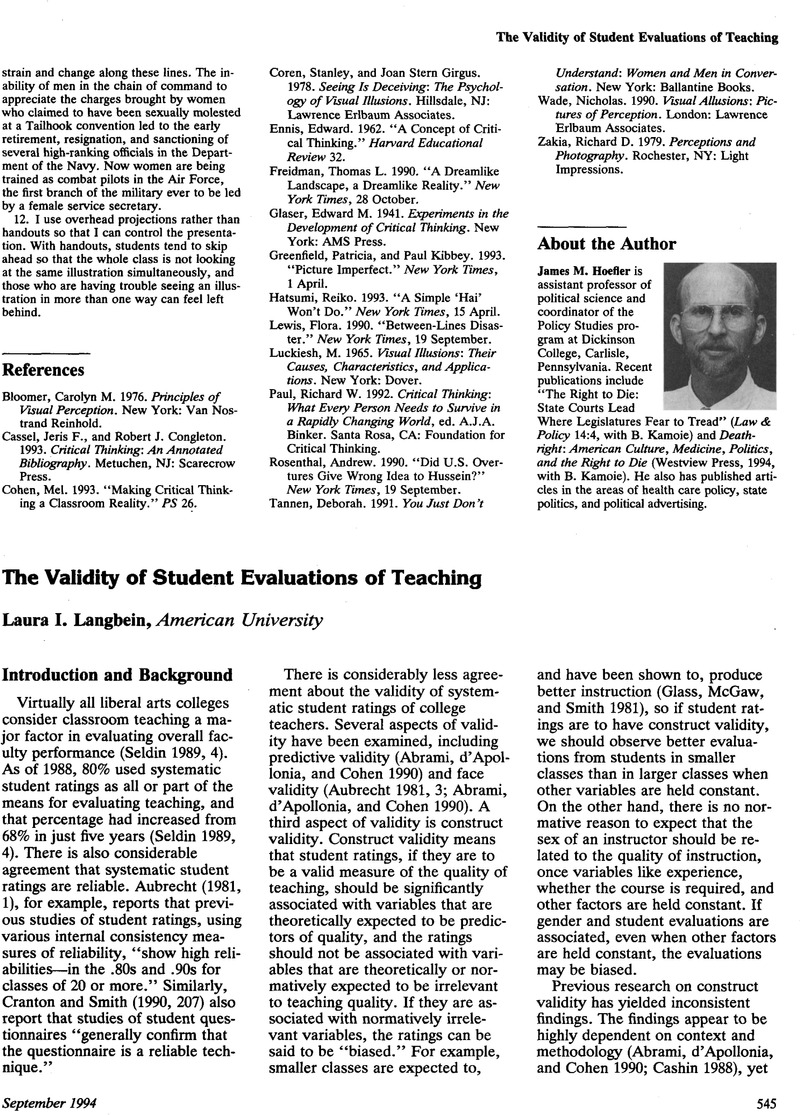Crossref Citations
This article has been cited by the following publications. This list is generated based on data provided by Crossref.
Andersen, Kristi
and
Miller, Elizabeth D.
1997.
Gender and Student Evaluations of Teaching.
PS: Political Science & Politics,
Vol. 30,
Issue. 2,
p.
216.
Snare, Charles E.
2000.
An Alternative End-of-Semester Questionnaire.
PS: Political Science & Politics,
Vol. 33,
Issue. 4,
p.
823.
Baldwin, Tamara
and
Blattner, Nancy
2003.
Guarding Against Potential Bias in Student Evaluations: What Every Faculty Member Needs to Know.
College Teaching,
Vol. 51,
Issue. 1,
p.
27.
Liaw, Shu‐Hui
and
Goh, Kim‐Leng
2003.
Evidence and control of biases in student evaluations of teaching.
International Journal of Educational Management,
Vol. 17,
Issue. 1,
p.
37.
Petridou, Eugenia
and
Sarri, Katerina
2004.
Evaluation research in business schools: students’ rating myth.
International Journal of Educational Management,
Vol. 18,
Issue. 3,
p.
152.
Lee, S. W.
and
Lee, K. H.
2005.
A Study on Controlling the External Effect in Student Evaluation of Teaching.
Communications for Statistical Applications and Methods,
Vol. 12,
Issue. 3,
p.
589.
Sampaio, Anna
2006.
Women of Color Teaching Political Science: Examining the Intersections of Race, Gender, and Course Material in the Classroom.
PS: Political Science & Politics,
Vol. 39,
Issue. 04,
p.
917.
Albrecht, W. Steve
and
Hoopes, Jeff
2009.
An empirical assessment of commercial web-based professor evaluation services.
Journal of Accounting Education,
Vol. 27,
Issue. 3,
p.
125.
De Witte, Kristof
and
Rogge, Nicky
2011.
Accounting for exogenous influences in performance evaluations of teachers.
Economics of Education Review,
Vol. 30,
Issue. 4,
p.
641.
Parpala, Anna
Lindblom‐Ylänne, Sari
and
Rytkönen, Henna
2011.
Students’ conceptions of good teaching in three different disciplines.
Assessment & Evaluation in Higher Education,
Vol. 36,
Issue. 5,
p.
549.
Rucker, Margaret H.
and
Haise, Carrie L.
2012.
Effects of variations in stem and response options on teaching evaluations.
Social Psychology of Education,
Vol. 15,
Issue. 3,
p.
387.
Morley, Donald D.
2012.
Claims about the reliability of student evaluations of instruction: The ecological fallacy rides again.
Studies in Educational Evaluation,
Vol. 38,
Issue. 1,
p.
15.
Mashaw, Bijan
2012.
A Model for Measuring Effectiveness of an Online Course.
Decision Sciences Journal of Innovative Education,
Vol. 10,
Issue. 2,
p.
189.
Blair, Erik
and
Valdez Noel, Keisha
2014.
Improving higher education practice through student evaluation systems: is the student voice being heard?.
Assessment & Evaluation in Higher Education,
Vol. 39,
Issue. 7,
p.
879.
Morley, Donald
2014.
Assessing the reliability of student evaluations of teaching: choosing the right coefficient.
Assessment & Evaluation in Higher Education,
Vol. 39,
Issue. 2,
p.
127.
Esarey, Justin
and
Valdes, Natalie
2020.
Unbiased, reliable, and valid student evaluations can still be unfair.
Assessment & Evaluation in Higher Education,
Vol. 45,
Issue. 8,
p.
1106.
Leong, Pamela
2020.
Rating Professors Online.
p.
25.
Bart, William M.
and
Can, Iclal
2022.
An investigation of the factor structure of student ratings of teaching at a Midwestern public university in the USA.
Assessment & Evaluation in Higher Education,
Vol. 47,
Issue. 7,
p.
998.
Cowan, Michelle
Fox, Gavin
and
Larson, Keri
2024.
Can AI Level the Playing Field? How AI-Assisted Assessment Impacts Gender Bias in Student Evaluations of Marketing Instructors.
Journal of Marketing Education,
Abuljadayel, Jameel
and
Abed, Hassan
2024.
Variables influencing students’ course quality evaluation: A cross‐sectional study for a bachelor's degree dental program.
Journal of Dental Education,
Vol. 88,
Issue. 8,
p.
1055.



